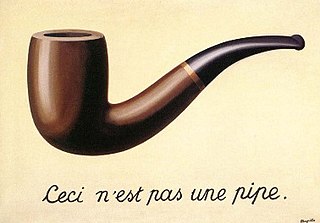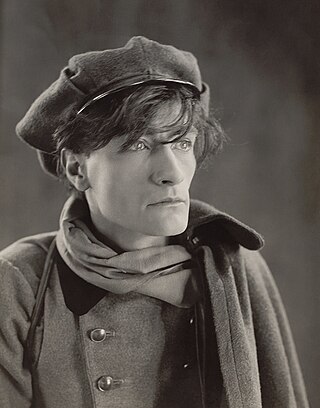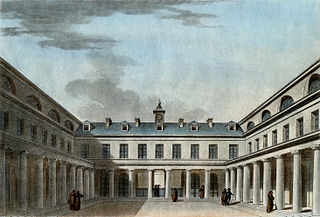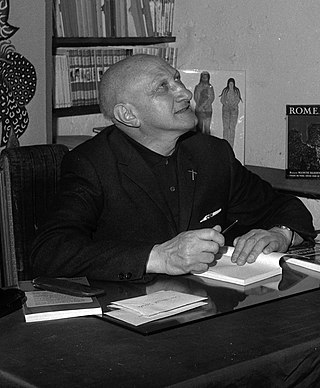
Surrealism is a cultural movement that developed in Europe in the aftermath of World War I in which artists depicted unnerving, illogical scenes and developed techniques to allow the unconscious mind to express itself. Its aim was, according to leader André Breton, to "resolve the previously contradictory conditions of dream and reality into an absolute reality, a super-reality", or surreality. It produced works of painting, writing, theatre, filmmaking, photography, and other media.
This article contains information about the literary events and publications of 1896.

Antoine Marie Joseph Paul Artaud, better known as Antonin Artaud, was a French artist who is widely recognized as a major figure of the European avant-garde. He worked across a variety of media, but is best known for his writings, as well as his work in the theatre and cinema. He had a profound influence on twentieth-century theatre through his conceptualization of the Theatre of Cruelty. Known for his raw, surreal and transgressive work, his texts explored themes from the cosmologies of ancient cultures, philosophy, the occult, mysticism and indigenous Mexican and Balinese practices.
The Theatre of Cruelty is a form of theatre conceptualised by Antonin Artaud. Artaud, who was briefly a member of the surrealist movement, outlined his theories in a series of essays and letters, which were collected as The Theatre and Its Double. The Theatre of Cruelty can be seen as a break from traditional Western theatre and a means by which artists assault the senses of the audience. Artaud's works have been highly influential on artists including Jean Genet, Jerzy Grotowski, Peter Brook, and Romeo Castellucci.
20th-century French literature is literature written in French from 1900 to 1999. For literature made after 1999, see the article Contemporary French literature. Many of the developments in French literature in this period parallel changes in the visual arts. For more on this, see French art of the 20th century.
Robert Aron (1898–1975) was a French historian and writer who wrote a number of books on politics and European history.
In France, the Concours Général is the most prestigious academic competition held every year between students of Première and Terminale in almost all subjects taught in both general, technological and professional high schools. Exams usually take place in March, and their results are known in June or July. Students who show great ability in one field are selected to participate by their teachers and their school principal. Most of the time, no more than one student per high school is allowed to participate in the competition, which requires strong knowledge of college level topics. In the humanities and social sciences, the exams involve one or more essays and last 6 hours. In the sciences, the exams last almost as long and are problem-based.

The Lycée Condorcet is a school founded in 1803 in Paris, France, located at 8, rue du Havre, in the city's 9th arrondissement. It is one of the four oldest high schools in Paris and also one of the most prestigious. Since its inception, various political eras have seen it given a number of different names, but its identity today honors the memory of the Marquis de Condorcet. The school provides secondary education as part of the French education system. Henri Bergson, Horace Finaly, Claude Lévi-Strauss, Marcel Proust, Jean-Luc Marion, Francis Poulenc and Paul Verlaine are some of the students who attended the Lycée Condorcet.

Roger Vitrac was a French surrealist playwright and poet.

Maxime Jacob, or Dom Clément Jacob, was a French composer and organist.
Events from the year 1898 in France.
This is an incomplete list detailing the codenames and aliases used by F Section agents of the Special Operations Executive.
Françoise Berd was a Canadian actress and founder of the Québécois experimental theatre company Théâtre de L'Égrégore.
Jacques Erwin was a French film and stage actor. Erwin was born in Paris, France. He was known for his roles in Remontons les Champs-Élysées (1938), Les cinq gentlemen maudits (1931), and Katia (1938). He died on April 7, 1957 in Saint-Tropez, Var, France.
Maxime Fabert, real name Robert Émile Jaillon, was a French stage and film actor. Maxime Fabert managed the Theater of the Comédie-Wagram from 1946 to 1962.
The Prix Sainte-Beuve, established in 1946, is a French literary prize awarded each year to a writer in the categories "novels" and "essays" ; it is named after the writer Charles-Augustin Sainte-Beuve. The founding jury included Raymond Aron, Maurice Blanchot, Edmond Buchet, Maurice Nadeau, Jean Paulhan and Raymond Queneau.
Bérengère Dautun, whose first name is sometimes written Bérangère whose real name is Bérengère Marie Gaubens-Cabrol, is a French actress, resident of the Comédie-Française in 1964, then member of the society from 1972 to 1997. She is the wife of the surgeon Christian Cabrol since 1998.





